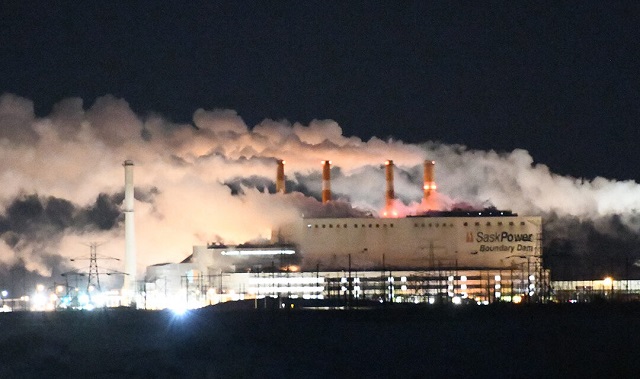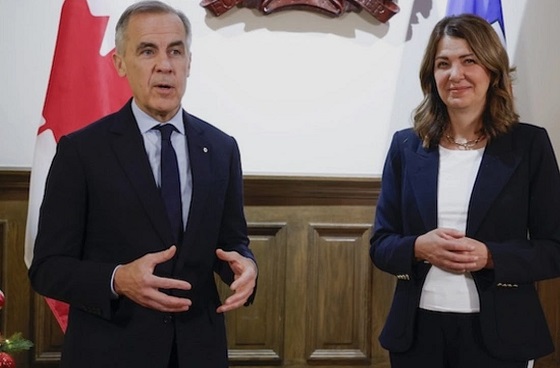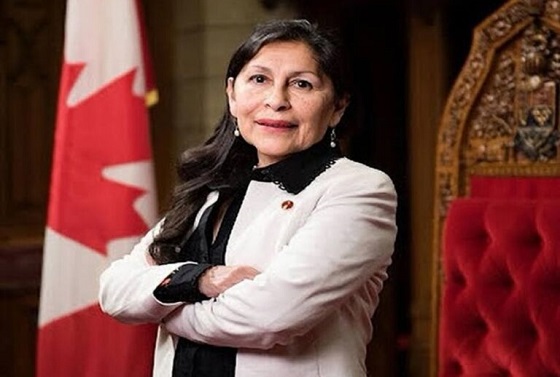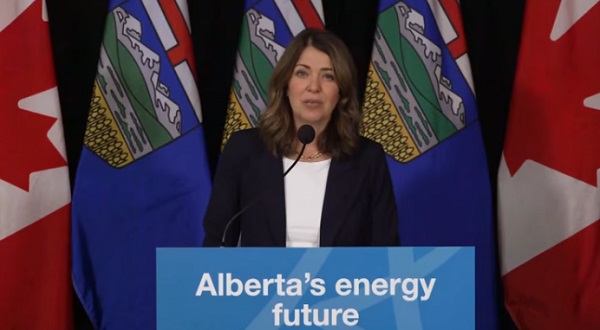Alberta
Alberta’s close brush with blackouts stiffens Moe’s resolve

From the Frontier Centre for Public Policy
“We will not risk plunging our homes, schools, hospitals, special care homes and our businesses into the cold and darkness because of the ideological whims of others.”
Alberta’s close brush with possible rolling blackouts stiffens Moe’s resolve to keep the lights on.
Moe reiterates: “We will not attempt the impossible when it comes to power production”
The past weekend proved to be a close-run thing for the Alberta electrical grid, and Saskatchewan Premier Scott Moe is making statements resolving he won’t allow that to happen here.
Specifically, after having nearly completely divested itself of coal-fired power production, Alberta’s dramatic buildout of wind and solar proved impossible to keep the lights on in that province when the chips were down and temperatures hit -35 C, or worse.
“In Saskatchewan, we will not attempt the impossible when it comes to power production in our province,” Moe said in a post on X and other social media the evening of Monday, Jan. 15.
“We will not risk plunging our homes, schools, hospitals, special care homes and our businesses into the cold and darkness because of the ideological whims of others.
“To support the ongoing power demands across western Canada, Boundary Dam 4 has been restarted to ensure families can continue to keep the heat on. Net zero by 2035 is not only impossible, it’s irresponsible as it would leave Saskatchewan and Western Canadian families freezing and in the dark.”
It was in response to the extraordinary events that occurred in Alberta over the weekend, in which Saskatchewan played a key part. And it was also a tacit acknowledgement that as much as SaskPower’s been trying to wean itself off coal, it just can’t do it yet. We still need it to keep the lights on.
The Alberta Electric System Operator (AESO) declared four “grid alerts,” over four days in a row, starting the afternoon of Friday, Jan. 12. Desperately cold temperatures drove up demand for power, just as the same temperatures reduced wind power generation to nothing at times, and close to nothing for most of the weekend. And since the mass of cold air stretched from the Yukon to Texas, every grid operator in between was in the same boat – high demand but short supply. The Southwest Power Pool, which incorporates parts of 14 states from south of Saskatchewan to the Texas Panhandle, as well as Texas grid operator ERCOT, all put out various forms of alerts suggesting their clients reduce electrical consumption.
Staring into the abyss
The first three of Alberta’s grid alerts ran from mid-afternoon until late evening, but the fourth occurred for an hour on Monday morning, as the workweek began.
The second of those grid alerts turned out to be the most significant. On Saturday, Jan. 13, Alberta came within a half-hour of rotating blackouts, an Alberta Electric System Operator spokesperson told CBC News on Jan. 15, confirmed by Alberta Affordability and Utilities Minister Nathan Neudorf the same day.
Indeed, the province stood at the brink of the abyss Saturday night, as rotating blackouts would have impacted different areas of the province for 20 to 30 minutes at a time, as temperatures ranged from -30 to -45 C, depending on where you were in the province. As the province’s grid-scale batteries neared depletion, and there was nothing left to call upon, the AESO and provincial government put out an emergency alert to all cellphones and TV screens, asking Albertans to shut off and unplug everything they could, from electric vehicle chargers to ovens to bathroom fans.
SaskPower ups its game
Alberta had run out of reserves, and with British Columbia unable to provide much more in the way of additional power, and Montana unable provide much at all, Saskatchewan’s Crown utility SaskPower responded, by sending 153 megawatts westward.
And that, in itself, was extraordinary, because limits were pushed to provide Alberta with as much as possible on the intertie between the two provinces.
SaskPower spokesperson Joel Cherry told Pipeline Online by email, “One hundred fifty-three megawatts is the interconnection’s maximum capacity, but it has been derated to 90 megawatts for the past several months because of ongoing work at a interconnection station at the border. AESO and SaskPower Grid Control have agreed to temporarily increase the transmission capacity to make the extra 63 MW available to Alberta when they declare energy alerts.
Contingency reserve had run out
Generally speaking, power needs to be consumed at the instant its produced. There is very little in the way of grid-scale storage in the Canadian electrical grid, although Alberta has built 10 grid-scale batteries totaling 190 megawatts capacity. All of that capacity would come into play Saturday evening.
Grid operators must maintain a small amount of excess capacity at all times, known as a “dispatched contingency reserve” (DCR) The North American Electric Reliability Corporation (NERC) standard is to maintain at least 4 per cent DCR. That’s because if the DCR runs out, all sorts of bad things happen, with voltage drops and frequency variance which then can lead to cascading brownouts, including additional power generating units tripping off and whole areas going without power.
With demand hovering around 11,800 megawatts, four per cent would have been around 472 megawatts DRC. Instead, for the better part of an hour, the DCR was 20 megawatts, or 0.1 per cent, a razor thin margin. The extra 63 megawatts SaskPower sent in part meant the difference between rotating blackouts or not.
In a very real way, it was payback for Alberta’s weeks-long help for SaskPower during the outage of the Poplar River Power Station at Coronach, Saskatchewan. For weeks on end, Alberta supplied Saskatchewan with around 150 megawatts for parts of the day to keep the lights on in this province.
BC played critical role, too
On any given day, imports and exports of power between Alberta and British Columbia will often run up to 600 megawatts going either direction. But with BC also in the deep freeze, it didn’t have much to give at various points during the weekend, including parts of the crucial Saturday evening. Indeed, around the time the grid alert was first sounded on Saturday, Alberta was still exporting 38 megawatts to British Columbia, according to X bot account @ReliableAB, which posts hourly data from the AESO on the status of the Alberta grid.
For a few hours, BC Hydro was able to ramp up its exports to Alberta during the crucial time. At 5:39, they were exporting 251 megawatts to Alberta, nearly 100 megawatts more than Saskatchewan. For the next few hours they sent around 200 megawatts, but it was not enough, and the AESO sent out its alert.
Additionally, during the third grid alert on Sunday, British Columbia ramping up its power exports at a critical time saved the day, as the Alberta Dispatched Contingency Reserve had briefly hit zero. BC bumped its exports up to 496 megawatts while Saskatchewan contributed 153 and Montana nine. Those increased megawatts from British Columbia appeared to make all the difference on that day.
The cat came back, and so did Unit 4
While all of this was going on, SaskPower spent the weekend getting its coal fired power station Boundary Dam Unit 4 back into play. It’s been on cold standby for months. Officially, by federal regulations it was supposed to retire Dec. 31, 2021, but SaskPower has been forced to bring it back into service multiple times to fill a need, such as when Poplar River went offline last June. It was 139 megawatts that could have been used, but SaskPower has shown reluctance to bring it back into the game, as it were.
And that’s what Moe alluded to in his social media post, saying, “We will not risk plunging our homes, schools, hospitals, special care homes and our businesses into the cold and darkness because of the ideological whims of others.”
This was an oblique reference to the push by the federal government to shut down coal and natural gas-fired power generation by 2035, according to the proposed Clean Electricity Regulations, using similar words that Moe has expressed before. The federal preference is for more renewables, in particular wind and solar.
Several years ago, the federal government and Saskatchewan reached an equivalency agreement, recognizing the Boundary Dam Unit 3 Carbon Capture and Storage Project and therefore allowing a few more years operation out of other coal units. But to get that agreement, SaskPower had to agree to adding a further 3,000 megawatts of wind and solar by 2035, according to SaskPower president and CEO Rupen Pandya in an interview Sept. 25, 2023.
Pandya said, “When we signed the equivalency agreement with the federal government in 2014 to allow us to keep using coal to the end of 2030, part of that agreement required us to build out renewables in the province, so that we could operate coal assets, coal generators, past their end of life. And that’s what we’ve been able to do. And we continue to do. So, part of the build out of renewables that’s required as part of the equivalency agreement, that 3,000 megawatts that we need to put in place by 2035. I think 2,000 by 2030. A good tranche of that will be in that south central part of Saskatchewan around the Coronach. So we currently have in the market an RFP for 700 megawatts of wind and solar in the Coronach region, so it’ll will actually go into power, if all goes well with RFPs, in 2027.”
On a typical fall day, SaskPower’s total power demand hovers around 3,000 megawatts. On a cold winter day, it’s closer to 3,500 megawatts. But that’s before widespread adoption of electric vehicles, which the federal government is also trying to force upon Canadians.
Saskatchewan held up to the cold
SaskPower’s Joel Cherry told Pipeline Online on Jan. 15, “Saskatchewan’s system has held up during the extreme cold. We had no major issues.”
However, “Poplar River Power Station was operating at reduced capacity earlier in the weekend because of issues with coal supply. As of yesterday (Sunday) we are back to normal operations there.”
That means the reduced capacity occurred the same day Alberta was stretched nearly to the breaking point.
Asked if we lost a major unit, while Alberta was at the same time in crisis, what did we have for backup? Was there additional capacity available from Manitoba and/or Southwest Power Pool?” Cherry replied, “SaskPower has maintained adequate reserves to allow for the continued stability of the system even if we lost a large unit. We have also been importing from Manitoba and the SPP when available.
Collapse of wind
Major factors in Alberta’s power woes were the utter collapse of wind and solar power generation. Even at its best, solar power production during the day was around a third of maximum capacity.
Wind turbines started shutting down Thursday night as temperatures plummeted below -30 C, the temperature where cold brittle behaviour of materials risks catastrophic failure of the turbines. The three evening grid alerts all came on as the sun went down and the roughly 500 megawatts (of 1,650 megawatts capacity) faded with the setting sun. On Friday, Alberta’s wind generation fell to 6 megawatts at one point. It was minimal on Saturday. On Sunday morning, multiple times wind hit zero – not one megawatt from the 4,481 megawatts of wind generation capacity.
SaskPower’s Where Your Power Comes From webpage noted on Friday, Jan. 14, Saskatchewan’s 617 megawatts of grid-scale wind produced a 24-hour average of 21 megawatts. On Saturday, that number was 19. On Sunday, the average was 22 megawatts. Unlike the previous week, where there were seven days where wind in Saskatchewan hit zero power output, Jan. 12-14 did not have any periods of zero.
“We had four hours of less than 10 megawatts wind output on Jan 12, despite the low average through the day on Jan. 13 we only had a half hour below 10 megawatts and on Jan 14 we had 7.8 hours below 10 megawatts,” Cherry said.
Ten megawatts is 1.6 per cent of total grid-scale wind capacity in Saskatchewan.
As for Unit 4, in April of 2023, Pipeline Online reported Cherry said at the time, “We’re going to keep BD 4 in laid up status until Great Plains Power Station comes online, or until March 31, 2024.”
The most recent plan, as of April, 2023, was to shut down, for good, Unit 4 by March 31, 2023. Whether Moe’s statement on Jan. 15 will extend that is unknown at the time of writing.
Brian Zinchuk is editor and owner of Pipeline Online, and occasional contributor to the Frontier Centre for Public Policy. He can be reached at [email protected]. For further information read the original publication here.
Alberta
IEA peak-oil reversal gives Alberta long-term leverage

This article supplied by Troy Media.
The peak-oil narrative has collapsed, and the IEA’s U-turn marks a major strategic win for Alberta
After years of confidently predicting that global oil demand was on the verge of collapsing, the International Energy Agency (IEA) has now reversed course—a stunning retreat that shatters the peak-oil narrative and rewrites the outlook for oil-producing regions such as Alberta.
For years, analysts warned that an oil glut was coming. Suddenly, the tide has turned. The Paris-based IEA, the world’s most influential energy forecasting body, is stepping back from its long-held view that peak oil demand is just around the corner.
The IEA reversal is a strategic boost for Alberta and a political complication for Ottawa, which now has to reconcile its climate commitments with a global outlook that no longer supports a rapid decline in fossil fuel use or the doomsday narrative Ottawa has relied on to advance its climate agenda.
Alberta’s economy remains tied to long-term global demand for reliable, conventional energy. The province produces roughly 80 per cent of Canada’s oil and depends on resource revenues to fund a significant share of its provincial budget. The sector also plays a central role in the national economy, supporting hundreds of thousands of jobs and contributing close to 10 per cent of Canada’s GDP when related industries are included.
That reality stands in sharp contrast to Ottawa. Prime Minister Mark Carney has long championed net-zero timelines, ESG frameworks and tighter climate policy, and has repeatedly signalled that expanding long-term oil production is not part of his economic vision. The new IEA outlook bolsters Alberta’s position far more than it aligns with his government’s preferred direction.
Globally, the shift is even clearer. The IEA’s latest World Energy Outlook, released on Nov. 12, makes the reversal unmistakable. Under existing policies and regulations, global demand for oil and natural gas will continue to rise well past this decade and could keep climbing until 2050. Demand reaches 105 million barrels per day in 2035 and 113 million barrels per day in 2050, up from 100 million barrels per day last year, a direct contradiction of years of claims that the world was on the cusp of phasing out fossil fuels.
A key factor is the slowing pace of electric vehicle adoption, driven by weakening policy support outside China and Europe. The IEA now expects the share of electric vehicles in global car sales to plateau after 2035. In many countries, subsidies are being reduced, purchase incentives are ending and charging-infrastructure goals are slipping. Without coercive policy intervention, electric vehicle adoption will not accelerate fast enough to meaningfully cut oil demand.
The IEA’s own outlook now shows it wasn’t merely off in its forecasts; it repeatedly projected that oil demand was in rapid decline, despite evidence to the contrary. Just last year, IEA executive director Fatih Birol told the Financial Times that we were witnessing “the beginning of the end of the fossil fuel era.” The new outlook directly contradicts that claim.
The political landscape also matters. U.S. President Donald Trump’s return to the White House shifted global expectations. The United States withdrew from the Paris Agreement, reversed Biden-era climate measures and embraced an expansion of domestic oil and gas production. As the world’s largest economy and the IEA’s largest contributor, the U.S. carries significant weight, and other countries, including Canada and the United Kingdom, have taken steps to shore up energy security by keeping existing fossil-fuel capacity online while navigating their longer-term transition plans.
The IEA also warns that the world is likely to miss its goal of limiting temperature increases to 1.5 °C over pre-industrial levels. During the Biden years, the IAE maintained that reaching net-zero by mid-century required ending investment in new oil, gas and coal projects. That stance has now faded. Its updated position concedes that demand will not fall quickly enough to meet those targets.
Investment banks are also adjusting. A Bloomberg report citing Goldman Sachs analysts projects global oil demand could rise to 113 million barrels per day by 2040, compared with 103.5 million barrels per day in 2024, Irina Slav wrote for Oilprice.com. Goldman cites slow progress on net-zero policies, infrastructure challenges for wind and solar and weaker electric vehicle adoption.
“We do not assume major breakthroughs in low-carbon technology,” Sachs’ analysts wrote. “Even for peaking road oil demand, we expect a long plateau after 2030.” That implies a stable, not shrinking, market for oil.
OPEC, long insisting that peak demand is nowhere in sight, feels vindicated. “We hope … we have passed the peak in the misguided notion of ‘peak oil’,” the organization said last Wednesday after the outlook’s release.
Oil is set to remain at the centre of global energy demand for years to come, and for Alberta, Canada’s energy capital, the IEA’s course correction offers renewed certainty in a world that had been prematurely writing off its future.
Toronto-based Rashid Husain Syed is a highly regarded analyst specializing in energy and politics, particularly in the Middle East. In addition to his contributions to local and international newspapers, Rashid frequently lends his expertise as a speaker at global conferences. Organizations such as the Department of Energy in Washington and the International Energy Agency in Paris have sought his insights on global energy matters.
Troy Media empowers Canadian community news outlets by providing independent, insightful analysis and commentary. Our mission is to support local media in helping Canadians stay informed and engaged by delivering reliable content that strengthens community connections and deepens understanding across the country.
Alberta
READ IT HERE – Canada-Alberta Memorandum of Understanding – From the Prime Minister’s Office

-

 Alberta5 hours ago
Alberta5 hours agoFrom Underdog to Top Broodmare
-

 Banks2 days ago
Banks2 days agoThe Bill Designed to Kill Canada’s Fossil Fuel Sector
-

 armed forces2 days ago
armed forces2 days ago2025 Federal Budget: Veterans Are Bleeding for This Budget
-

 Alberta1 day ago
Alberta1 day agoAlberta and Ottawa ink landmark energy agreement
-

 Artificial Intelligence2 days ago
Artificial Intelligence2 days agoTrump’s New AI Focused ‘Manhattan Project’ Adds Pressure To Grid
-

 International1 day ago
International1 day agoAfghan Ex–CIA Partner Accused in D.C. National Guard Ambush
-

 Carbon Tax1 day ago
Carbon Tax1 day agoCanadian energy policies undermine a century of North American integration
-

 International1 day ago
International1 day agoIdentities of wounded Guardsmen, each newly sworn in






